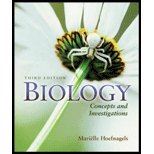
Concept explainers
Introduction:
The ability to do work is called energy. There are two types of energy, i.e. kinetic energy and potential energy. The energy which is in the stored form is called potential energy. Example of potential energy is drawing a bow, stretching of a rubber band. In the same way cell also required energy to do the work. Potential energy is stored in the bonds, which connects the atoms in molecules.
Answer to Problem 1MCQ
Correct answer:
The best example of potential energy in the cell is a molecule of glucose. Therefore, the option b. is correct.
Explanation of Solution
Reason for the correct statement:
A molecule of glucose can undergo both the glycolysis and the citric acid cycle pathway. It releases an ATP molecule in both the pathways using the electron transport chain. When the glucose molecule is broken down, they release energy. They are not an energy molecule, but can be broken down to from energy molecule ATP.
Option b. is given as potential energy in a cell is “A molecule of glucose”.
As, “the molecules of glucose break down and generates energy”, is the correct answer.
Hence, option b. is correct.
Reasons for the incorrect statements:
Option a. is given as “Cell division”.
Cell division is a process by which a parent cell divides into two daughter cells. The energy is exhausted during cell division. So, it is a wrong answer.
Option c. is given as “movement of a flagellum”.
The flagella are the motile structures that offer movement to cell. The flagella are the best example of kinetic energy. So, it is a wrong answer.
Option d. is given as “assembly of a cellulose fiber”.
The cellulose is a polysaccharide whose monomer is glucose. Here the cellulose fibers provide the structural framework to the cells. The energy stored in the cellulose cannot be utilized in the terms of energy. So, it is a wrong answer.
Hence, option a., c., and d. are incorrect.
Glucose is not an energy molecule, but can generate ATP, which is known as the powerhouse of the cell. It can be broken down to release energy. So glucose is an example of potential energy.
Want to see more full solutions like this?
Chapter 4 Solutions
Biology: Concepts and Investigations
- Which of the following is not a DNA binding protein? 1. the lac repressor protein 2. the catabolite activated protein 3. the trp repressor protein 4. the flowering locus C protein 5. the flowering locus D protein 6. GAL4 7. all of the above are DNA binding proteinsarrow_forwardWhat symbolic and cultural behaviors are evident in the archaeological record and associated with Neandertals and anatomically modern humans in Europe beginning around 35,000 yBP (during the Upper Paleolithic)?arrow_forwardDescribe three cranial and postcranial features of Neanderthals skeletons that are likely adaptation to the cold climates of Upper Pleistocene Europe and explain how they are adaptations to a cold climate.arrow_forward
- Biology Questionarrow_forward✓ Details Draw a protein that is embedded in a membrane (a transmembrane protein), label the lipid bilayer and the protein. Identify the areas of the lipid bilayer that are hydrophobic and hydrophilic. Draw a membrane with two transporters: a proton pump transporter that uses ATP to generate a proton gradient, and a second transporter that moves glucose by secondary active transport (cartoon-like is ok). It will be important to show protons moving in the correct direction, and that the transporter that is powered by secondary active transport is logically related to the proton pump.arrow_forwarddrawing chemical structure of ATP. please draw in and label whats asked. Thank you.arrow_forward
- Outline the negative feedback loop that allows us to maintain a healthy water concentration in our blood. You may use diagram if you wisharrow_forwardGive examples of fat soluble and non-fat soluble hormonesarrow_forwardJust click view full document and register so you can see the whole document. how do i access this. following from the previous question; https://www.bartleby.com/questions-and-answers/hi-hi-with-this-unit-assessment-psy4406-tp4-report-assessment-material-case-stydu-ms-alecia-moore.-o/5e09906a-5101-4297-a8f7-49449b0bb5a7. on Google this image comes up and i have signed/ payed for the service and unable to access the full document. are you able to copy and past to this response. please see the screenshot from google page. unfortunality its not allowing me attch the image can you please show me the mathmetic calculation/ workout for the reult sectionarrow_forward

 Concepts of BiologyBiologyISBN:9781938168116Author:Samantha Fowler, Rebecca Roush, James WisePublisher:OpenStax College
Concepts of BiologyBiologyISBN:9781938168116Author:Samantha Fowler, Rebecca Roush, James WisePublisher:OpenStax College Biology Today and Tomorrow without Physiology (Mi...BiologyISBN:9781305117396Author:Cecie Starr, Christine Evers, Lisa StarrPublisher:Cengage Learning
Biology Today and Tomorrow without Physiology (Mi...BiologyISBN:9781305117396Author:Cecie Starr, Christine Evers, Lisa StarrPublisher:Cengage Learning





